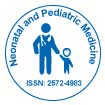Impact of Neonatal Intensive Care Units on Neuro-developmental Outcomes of Infants
Received: 23-Oct-2023 / Manuscript No. NNP-23-120582 / Editor assigned: 26-Oct-2023 / PreQC No. NNP-23-120582 / Reviewed: 09-Nov-2023 / QC No. NNP-23-120582 / Revised: 15-Nov-2023 / Manuscript No. NNP-23-120582 / Published Date: 22-Nov-2023 QI No. / NNP-23-120582
Short Communication
The Neonatal Integrative Developmental Care Model identifies seven distinct core measures that provide clinical guidance for neonatal intensive care units staff in delivering neuro-protective family-centred developmental care to preterm infants and their families in the neonatal intensive care units. Each core measure has a standard with a policy or protocol that guides care of the infant as it relates to that specific core measure [1]. Corresponding infant characteristics, which are measurable reflections of the desired core measure outcomes, are identified, and specific goals target the improvements desired. Clinical applications include neuro-protective Interventions that define and specify the actions required to meet the goals. These must be evidencebased, reliably applied and scientifically valid [2]. To effectively implement many neuro-protective interventions, a cultural shift within the neonatal intensive care units must occur in order to adopt new evidence-based practices. Changes in care practices are usually not easy and success is dependent on introducing change in a systematic fashion. Quality improvement methods such Plan have proven effective in initiating and sustaining changes that can result in improved outcomes. One such program is the Wee Care Neuro-protective care program [3]. The Wee Care neuro-protective neonatal intensive care units Program is a multiday multidisciplinary structured program in neuro-protective family-centred developmental care, which provides eLearning, didactic education, hands-on interactive workshops, physician sessions, and inunit consultation to all individuals who care for premature infants in a neonatal intensive care unit [4]. This training and consultative program is an evidence-based quality improvement program designed to optimize the neonatal intensive care units environment and caregiving practices in order to facilitate the best outcomes for premature infants and their families [5]. This unique program combines evidence-based practices with the seven neuro-protective core measures for familycentred developmentally supportive care aimed at standardizing neuroprotective care practices in the neonatal intensive care units. This is achieved and sustained by incorporating transformational change methodology into the training program [6]. The Wee Care Neuroprotective NICU Program, which trains all neonatal intensive care units staff has been shown to improve noise and light levels in the NICU, improve infant medical outcomes, improve staff satisfaction, improve family satisfaction, decrease length of stay, and decrease hospital costs. Skin-to-skin contact is the optimal environment for any new-born, but particularly for the premature infant in the neonatal intensive care units. The defining feature of Skin-to-skin contact is direct contact between parental skin and infant skin, by holding a diaper-clad infant on a parent’s bare chest in an upright prone position [7]. Essentially, this is a place of care, the normal environment for new-borns. Skinto- skin contact provides the right environment for DNA, Epigenes, neural circuits and physiological regulation to function most optimally. A mother and her baby are inextricably linked and to separate the two is highly stressful to both [8]. Incubator care, while necessary if mother is unavailable, is actually abnormal to the developing brain of an infant. Skin-to-skin contact is a fundamental, essential component of neuroprotective and patient-family oriented care for hospitalized preterm infants [9]. Being skin to skin with mother protects the new born from the well-documented negative effects of separation, supports optimal brain development and facilitates attachment, which promotes the infant’s self-regulation over time. Skin-to-skin contact became codified through the World Health Organization into what is called kangaroo mother care, a full-care strategy [10].
Acknowledgement
None
Conflict of Interest
None
References
- Cunningham AA, Daszak P, Wood JLN (2017) One Health, emerging infectious diseases and wildlife: two decades of progress? Phil Trans UK 372:1-8.
- Sue LJ (2004) Zoonotic poxvirus infections in humans. Curr Opin Infect Dis MN 17:81-90.
- Pisarski K (2019) The global burden of disease of zoonotic parasitic diseases: top 5 contenders for priority consideration. Trop Med Infect Dis EU 4:1-44.
- Kahn LH (2006) Confronting zoonoses, linking human and veterinary medicine. Emerg Infect Dis US 12:556-561.
- Bidaisee S, Macpherson CNL (2014) Zoonoses and one health: a review of the literature. J Parasitol 2014:1-8.
- Cooper GS, Parks CG (2004) Occupational and environmental exposures as risk factors for systemic lupus erythematosus. Curr Rheumatol Rep EU 6:367-374.
- Parks CG, Santos ASE, Barbhaiya M, Costenbader KH (2017) Understanding the role of environmental factors in the development of systemic lupus erythematosus. Best Pract Res Clin Rheumatol EU 31:306-320.
- Barbhaiya M, Costenbader KH (2016) Environmental exposures and the development of systemic lupus erythematosus. Curr Opin Rheumatol US 28:497-505.
- Cohen SP, Mao J (2014) Neuropathic pain: mechanisms and their clinical implications. BMJ UK 348:1-6.
- Mello RD, Dickenson AH (2008) Spinal cord mechanisms of pain. BJA US 101:8-16.
IndexedAt , Google Scholar, Crossref
Indexed at, Google Scholar, Crossref
Indexed at, Google Scholar, Crossref
Indexed at, Google Scholar, Crossref
Indexed at, Google Scholar, Crossref
Indexed at, Google Scholar, Crossref
Indexed at, Google Scholar, Crossref
Indexed at, Google Scholar, Crossref
Indexed at, Google Scholar, Crossref
Citation: Biru G (2023) Impact of Neonatal Intensive Care Units onNeurodevelopmental Outcomes of Infants. Neonat Pediatr Med 9: 366.
Copyright: © 2023 Biru G. This is an open-access article distributed under theterms of the Creative Commons Attribution License, which permits unrestricteduse, distribution, and reproduction in any medium, provided the original author andsource are credited.
Share This Article
Recommended Conferences
42nd Global Conference on Nursing Care & Patient Safety
Toronto, CanadaRecommended Journals
Open Access Journals
Article Usage
- Total views: 512
- [From(publication date): 0-2023 - Apr 03, 2025]
- Breakdown by view type
- HTML page views: 322
- PDF downloads: 190
